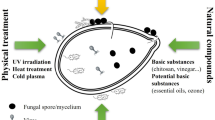Abstract
In this study, an approach based on seed treatment was undertaken to enhance resistance of Nicotiana benthamiana against wild fire disease caused by Pseudomonas syringae pv. tabaci. Seeds soaked in 10 μg ml−1 of three hemi-synthetic triterpenes (F3, F4 and F6) derived from the latex of Euphorbia officinarum and Euphorbia resinifera resulted in plants with reduced disease severity, which was correlated with a decrease of bacterial populations in planta. Analysis of plant defense markers revealed that H2O2 and guaiacol peroxidase were only slightly activated but were primed after pathogen infiltration. However, polyphenol oxidase, catalase and ascorbate peroxidase were directly induced by the triterpenic derivatives. These results underline the duality of the mode of action of the triterpenic compounds and suggest their use as plant defense inducers in crop protection.






Similar content being viewed by others
References
Alexieva V, Sergiev I, Mapelli S, Karanov E (2001) The effect of drought and ultraviolet radiation growth and stress markers in pea and wheat. Plant Cell Environ 24:1337–1344
Ali SS, Kumar GB, Khan M, Doohan FM (2013) Brassinosteroid enhances resistance to fusarium diseases of barley. Phytopathology 103:1260–1267
Almagro L, Gómez Ros LV, Belchi-Navarro S, Bru R, Ros Barceló A, Pedreño MA (2009) Class III peroxidases in plant defence reactions. J Exp Bot 60:377–390
Bajguz A, Hayat S (2009) Effects of brassinosteroids on the plant responses to environmental stresses. Plant Physiol Biochem 47:1–8
Borges AA, Jiménez-Arias D, Expósito-Rodríguez M, Sandalio LM, Pérez JA (2014) Priming crops against biotic and abiotic stresses: MSB as a tool for studying mechanisms. Front Plant Sci 5:642. https://doi.org/10.3389/fpls.2014.00642
De Costa F, Yendo AC, Fleck JD et al (2013) Accumulation of a bioactive triterpene saponin fraction of Quillaja brasiliensis leaves is associated with abiotic and biotic stresses. Plant Physiol Biochem 66:56–62
Deng XG, Zhu T, Peng XJ, Xi DH, Guo HQ, Yin Y, Zhang DW, Lin HH (2016) Role of brassinosteroid signaling in modulating tobacco mosaic virus resistance in Nicotiana benthamiana. Sci Rep 6:20579. https://doi.org/10.1038/srep20579
Faize M, Burgos L, Faize L, Petri C, Barba-Espin G, Díaz-Vivancos P, Clemente-Moreno MJ, Alburquerque N, Hernandez JA (2012) Modulation of tobacco bacterial disease resistance using cytosolic ascorbate peroxidase and Cu,Zn-superoxide dismutase. Plant Pathol (5):858–866
Faize M, Faize L, Petri C, Barba-Espin G, Diaz-Vivancos P, Clemente Moreno MJ, Koussa T, Rifai LA, Burgos L, Hernandez JA (2013) Cu/Zn superoxide dismutase and ascorbate peroxidase enhance in vitro shoot multiplication in transgenic plum. J Plant Physiol 170:625–632
Guo YS, Su XY, Cai LT, Wang HC (2017) Phenotypic characterisation of Pseudomonas syringae pv. tabaci, the causal agent of tobacco wildfire. J Plant Pathol 99:499–504
Khripach V, Zhabinskii VN, de Groot AE (2000) Twenty years of brassinosteroids: steroidal plant hormones warrant better crops for the XXI century. Ann Bot 86:441–447
Krol P, Igielski R, Pollmann S, Kepczynska E (2015) Priming of seeds with methyl jasmonate induced resistance to hemibiotroph Fusarium oxysporum f.Sp. lycopersici in tomato via 12-oxo-phytodienoic acid, salicylic acid and flavonol accumulation. J Plant Physiol 179:122–132
Masia A, Ventura M, Gemma H, Sansavini S (1998) Effect of some plant growth regulator treatments on apple fruit ripening. Plant Growth Regul 25:127–134
Moses T, Papadopoulou KK, Osbourn A (2014) Metabolic and functional diversity of saponins, biosynthetic intermediates and semi-synthetic derivatives. Crit Rev Biochem Mol Biol 49:439–462
Osbourn A, Goss RJ, Field RA (2011) The saponins: polar isoprenoids with important and diverse biological activities. Nat Prod Rep 28:1261–1268
Paudel S, Rajotte EG, Felton GW (2014) Benefits and costs of tomato seed treatment with plant defense elicitors for insect resistance. Arthropod Plant Interact 8:539–545
Petrov V.D., Van Breusegem F. (2012). Hydrogen peroxide-a central hub for information flow in plant cells. AoB Plants. pls014 https://doi.org/10.1093/aobpla/pls014
Smaili A, Mazoir N, Rifai LA, Koussa T, Makroum K, Kabil EM, Benharref A, Faize M (2017a) Triterpene derivatives from Euphorbia enhance resistance against Verticillium wilt of tomato. Phytochemistry 135:2662–2667
Smaili A, Mazoir N, Rifai LA, Koussa T, Makroum K, Benharref A, Faize L, Alburquerque N, Burgos L, Belfaiza M, Faize M (2017b) Antimicrobial activity of two semisynthetic triterpenic derivatives from Euphorbia officinarum latex against fungal and bacterial phytopathogens. Nat Prod Commun 12:331–336
Thimmappa R, Geisler K, Louveau T, O’Maille P, Osbourn A (2014) Triterpene biosynthesis in plants. Annu Rev Plant Biol 65:225–257
Vaughn KC, Lax AR, Duke SO (1988) Polyphenol oxidase-the chloroplast oxidase with no established function. Physiol Plant 72:659–665
Worral D, Holroyd GH, Moore JP, Glowacz M, Croft P, Taylor JE, Paul ND, Roberts MR (2012) Treating seeds with activators of plant defence generates long-lasting priming of resistance to pests and pathogens. New Phytol 193:770–778
Xia XJ, Wang YJ, Zhou YH, Tao Y, Mao WH, Shi K, Asami T, Chen Z, Yu JQ (2009) Reactive oxygen species are involved in brassinosteroid-induced stress tolerance in cucumber. Plant Physiol 150:801–814
Zhang DW, Deng XG, Fu FQ, Lin HH (2015) Induction of plant virus defense response by brassinosteroids and brassinosteroid signaling in Arabidopsis thaliana. Planta 241:875–885
Author information
Authors and Affiliations
Corresponding author
Rights and permissions
About this article
Cite this article
Smaili, A., Mazoir, N., Aicha Rifai, L. et al. Induced resistance to wild fire disease of Nicotiana benthamiana using seed treated with triterpene derivatives from Euphorbia. J Plant Pathol 100, 75–83 (2018). https://doi.org/10.1007/s42161-018-0031-0
Published:
Issue Date:
DOI: https://doi.org/10.1007/s42161-018-0031-0




